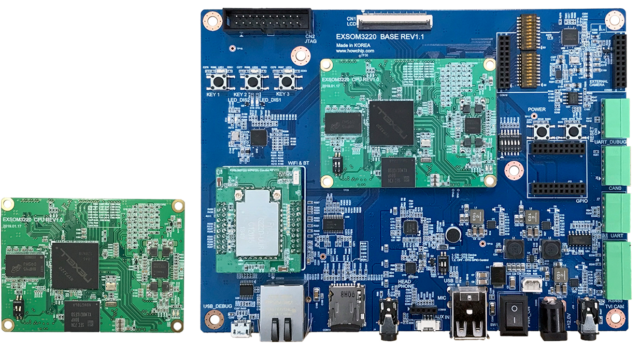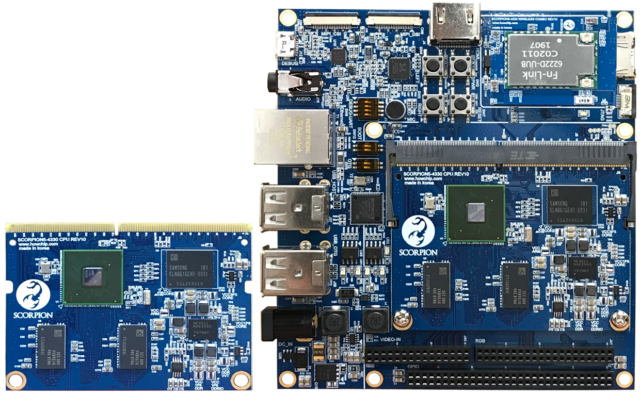Howchip has announced 2 development boards based on Nexell processors. Even though pricing is not available yet for these boards, we can now know their main features. Both development boards have been launched as COM & carrier development kits.
Scorpion 3 is mainly focused for developments where a powerful dual-core Arm Cortex-A7 NXP3220 featured with Linux 4.14 can be enough, and Scorpion 5 seems to be focused for applications which may have more intensive requirements, for instance in terms of user interface, being based on a quad-core Arm Cortex-A9 NXP4330Q featured with Android Nougat and with UI specific features like 3D-Graphics Accelerator.
Even though there is not so much information, Howchip also announces as “coming soon” the Scorpion 1 board, based on Exynos i T200 as an integrated IoT solution.
Howchip Scorpion 3

Howchip Scorpion 3 is a great embedded computer in a board whose form factor is only 68x50mm. Since it is based on Linux 4.14, you can develop using Qt 5.6.3 which includes voice extensions. It has a 24-bit RGB/LVDS controller with a 2D accelerator, 512MB DDR3, 8GB eMMC, and a PMIC. Powered by an Arm TrustZone microcontroller, with HW dedicated components for cryptographic operations, including even Elliptic Curve Support.
Incorporating a full set of electronic peripherals like 3 USBs, 7 UARTs, 3 SPIs, 5 I2Cs, 2 CAN bus and 8x 12-bits ADC; it is a great choice for most common IoT devices.
Howchip Scorpion 3 Specifications
- CPU
- 28 nm, HKMG (High-K Metal Gate) Process Technology
- Cortex-A7 Dual-Core CPU @ >1.0 GHz
- System Controller
- 5 x 32-ch DMAs (2 x DMA, 2 x Secure-DMA, 1 x MDMA)
- various Power Mode (Normal, Idle, Standby, Deep-standby)
- various boot modes including SPI Flash/EEPROM, Nand-Flash, SD (eMMC), USB and UART
- Memory/Storage Controller
- 16bit DDR3, DDR4 up to 1250 MHz
- various memory
- MLC/SLC NAND Flash with Hardwired ECC algorithm (4/8/12/16/24/40/60-bit)
- 3-ch SD/MMC
- FHD Multi-format video codec
- Full-HD Multi-Format Video Decoder
- Display Controller & Video Post-processor
- Display up to 1920X1080
- 1-ch LVDS Interface
- Video Input Processor
- 1-ch ITU BT656/601 Parallel Video Interface
- Connectivity
- 2-ch Controller Area Network V3.2.1.2
- 10/100M-bit Ethernet MAC (RMII I/F)
- 10/100/1000M-bit Ethernet MAC (RGMII I/F)- 3-ch SD/MMC
- 2-ch USB 2.0 Host, 1-ch USB 2.0 OTG
- Peripherals
- 7-ch UARTs, 4-ch Timer, Interrupt Controller, RTC
- 4-ch I2S, 5-ch I2C, 3-ch SPI, 4-ch PWM, and GPIOs
- 8-ch 12-bit ADC (with supports resistive touch panel)
- SPDIF, Supports 4-ch RS485
- 4-ch PDM data
- Security
- Security functions (AES, DES/TDES, SHA-1, MD5, PRNG, and TRNG) and Secure JTAG
- ARM Trust Zone technology
- Package
- 380 Ball FCBGA Package, 0.80 mm Ball Pitch, 17X17 mm Body size
HOWCHIP SCORPION 3 DISPLAYs
- 10.1 inch Capacitive Touch
- 1280 x 800 Resolution
- Mechanical Size 228.6mm x 149.2mm
- 10.4 inch Resistive Touch
- 1024 x 768 Resolution
- Mechanical Size 236mm x 176.9mm
- 8.0 inch Capacitive Touch
- 1024 x 600 Resolution
- Mechanical Size 192.8mm x 116.9mm
Howchip Scorpion 5

Howchip Scorpion 5 is a bigger computer with more powerful features in a 69.6 x 52mm board. It runs Android Nougat on Nexell’s quad-core, Cortex-A9 NXP4330Q. SoC is clocked to 1.4GHz and it also has a 3D accelerated GPU with HD video support. This board also has 2GB DDR3, 8GB eMMC, and a PMIC.
Even though its computer abilities are superior to Scorpion 3, its low-level peripheral set is not as rich. Anyway, it has a good enough set of them, like 2 USBs, 6 UARTs, 3 SPIs, 3 I2Cs, and 8 ADCs; making it a great choice for most common IoT devices.
Regarding User Interface, you will see the advantage in comparison with Scorpion 3: display I/O include an HDMI port plus 4-lane MIPI-DSI and LVDS interfaces and a 24-bit parallel connection (BT601/656). There are also MIPI-CSI and CCIR 656/601 camera inputs, an analog audio jack, and line-in, speaker, and mic interfaces
Howchip Scorpion 5 Specifications
- 28nm, HKMG (High-K Metal Gate) Process Technology
- 513 pin FCBGA Package, 0.65mm Ball Pitch, 17x17mm Body size
- Cortex-A9 Quad Core CPU @ 1.4GHz
- High-Performance 3D Graphic Accelerator
- Full-HD Multi-Format Video Codec
- Supports various memory: x32 LVDDR3(Low Voltage DDR3), DDR3 up to 800MHz
- Supports MLC/SLC NAND Flash with Hardwired ECC algorithm (4/8/12/16/24/40/60bit)
- Supports Dual Display up to 2048×1280, TFT-LCD, LVDS, HDMI 1.4a, MIPI-DSI output
- Supports 3-ch ITU BT656 Parallel Video Interface and MIPI-CSI
- Supports 10/100/1000M-bit Ethernet MAC
- Supports 3-ch SD/MMC, 5ch UARTs,32ch DMAs, 4ch Timer, Interrupt Controller, RTC
- Supports 3-ch I2S, SPDIF Rx/Tx, 3-ch I2C, 3-ch SPI, 8-ch 12bit ADC, 3-ch PWM and GPIOs, 1-ch PPM
- Supports MPEG-TS Parallel Interface and MPEG-TS HW Parser
- Supports 1ch USB 2.0 Host, 1ch USB 2.0 OTG, 1ch USB HSIC Host
- Supports Security functions (AES, DES/TDES, SHA-1, MD5, and PRNG) and Secure JTAG
- Supports various Power Mode (Normal, Sleep, Deep-Sleep, Stop)
- Supports various boot modes including SPI Flash/EEPROM, NOR, USB and UART
HOWCHIP SCORPION 5 DISPLAYs
- 8.0 inch Capacitive Touch
- 1024 x 600 Resolution
- Mechanical Size 192.8mm x 116.9mm
- 10.1 inch Capacitive Touch
- 1280 x 800 Resolution
- Mechanical Size 228.6mm x 149.2mm
INFORMATION SOURCES
Howchip Scorpion 3’s product page
Howchip Scorpion 5’s product page

I'm Javier Longares Abaiz, an electronic engineer with more than 15 years of professional experience developing new microcontroller-based products. During this time, I've developed dozens of products, and I can proudly say than some of them are currently being sold in more than 100 countries.
Nowadays I offer firmware and hardware consultancy services, including the development of new devices from scratch.
Support CNX Software! Donate via cryptocurrencies, become a Patron on Patreon, or purchase goods on Amazon or Aliexpress. We also use affiliate links in articles to earn commissions if you make a purchase after clicking on those links.





Nexell is a nice bunch of guys, they try really hard to help out when they can. Sadly their products are getting a tad long in the tooth for many applications these days, but it seems like their focus market is for vehicle entertainment and camera systems, or digital dashboards.
“powerfull dual Core a7”? Today? Really?
>“powerfull dual Core a7”? Today? Really?
Context is important. In segments that aren’t “playing emulators and torrented movies” where a microcontroller with a basic LCD controller is the norm a cortex a7 is comparatively fast.
i have written to them question about the price and if they have linux for it. I mean Scorpion 5 . No answer from week. I like such companies a lot.